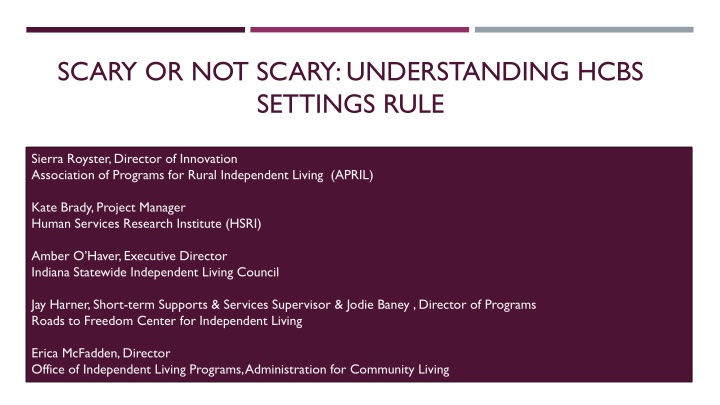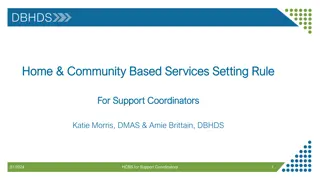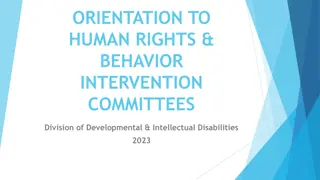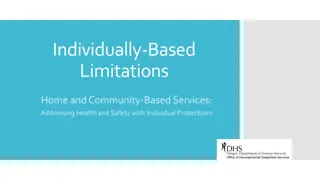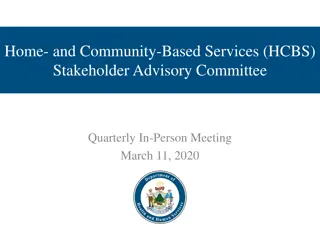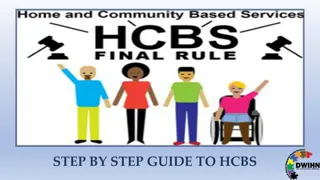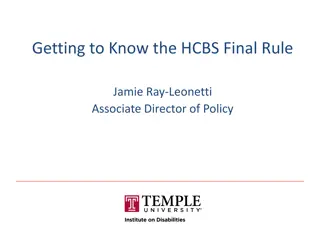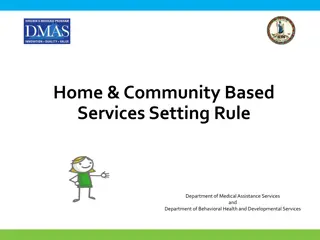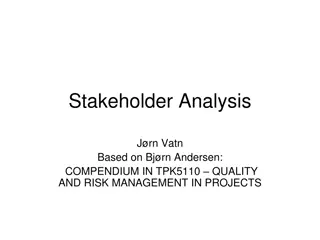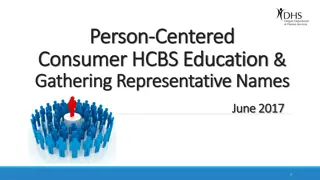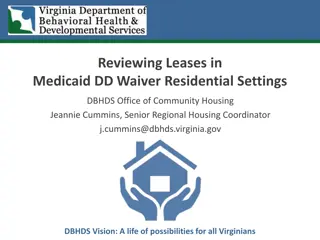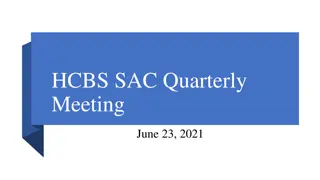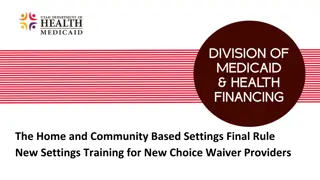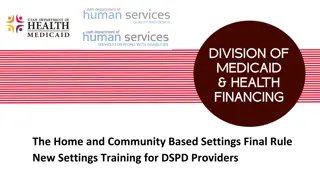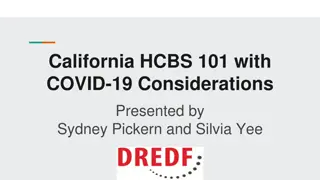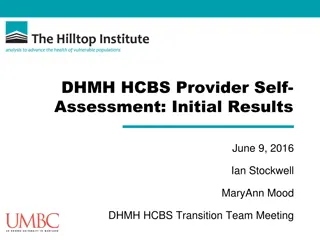HCBS Settings Rule and Stakeholder Partnerships
Explore the HCBS Settings Rule and stakeholder partnerships involving organizations like APRIL, NASILC, and HSRI. Learn about the objectives, stakeholders, and key partnerships in the Home and Community-Based Services sector. Understand the importance of HCBS in providing support services like employment, transportation, and homecare. Discover the origins and implications of the HCBS settings rule and how it impacts individuals receiving services.
Download Presentation

Please find below an Image/Link to download the presentation.
The content on the website is provided AS IS for your information and personal use only. It may not be sold, licensed, or shared on other websites without obtaining consent from the author.If you encounter any issues during the download, it is possible that the publisher has removed the file from their server.
You are allowed to download the files provided on this website for personal or commercial use, subject to the condition that they are used lawfully. All files are the property of their respective owners.
The content on the website is provided AS IS for your information and personal use only. It may not be sold, licensed, or shared on other websites without obtaining consent from the author.
E N D
Presentation Transcript
SCARY OR NOT SCARY: UNDERSTANDING HCBS SETTINGS RULE Sierra Royster, Director of Innovation Association of Programs for Rural Independent Living (APRIL) Kate Brady, Project Manager Human Services Research Institute (HSRI) Amber O Haver, Executive Director Indiana Statewide Independent Living Council Jay Harner, Short-term Supports & Services Supervisor & Jodie Baney , Director of Programs Roads to Freedom Center for Independent Living Erica McFadden, Director Office of Independent Living Programs, Administration for Community Living
OBJECTIVES Who are the stakeholders and important partners in your area? Start to understand the rule and how it applies to your work. Where do I find information on this rule? Knowing what to do next to promote these rules or to find the information around it.
PARTNERSHIP APRIL is working with NASILC and HSRI on the HCBS Settings Rule CILs have been doing this work for a long time, now there is language to support our philosophy on transition and diversion along with key partnerships we can use in our work. Our role: To bring awareness to our membership and IL partners on these rules To equip CILs and SILCs with the information to increase their advocacy around transition and diversion. To share resources with the IL field on the rules and how to educate your consumers and community. To inform CILs and SILCs on potential partners within your state and service areas to work on issues around transition and systems and individual advocacy. Help identify CILs and SILCs that are doing work around this that can provide some peer mentoring for others.
HOME AND COMMUNITY-BASED SERVICES STAKEHOLDER ENGAGEMENT KATE BRADY, PHD ABD PROJECT MANAGER, NCAPPS AT THE HUMAN SERVICES RESEARCH INSTITUTE
THE WHAT AND WHO OF HCBS What are Home and Community-Based Services (HCBS)? HCBS provide funded support for : Employment Transportation Homecare/home health Who receives HCBS? In 2018 more than 4.7 million people received Medicaid-funded HCBS Each state has its own system and decides to which populations they will offer HCBS waivers Medications and in-home therapy (PT, OT, Speech, etc.) Housekeeping Activities of daily living such as bathing, dressing, toileting and cooking . Finances Assistive Technology and Home Modifications 5
SETTINGS RULE: WHERE IT CAME FROM AND WHERE IT S GOING People living in community-based settings were often living a life that is closer to institutional experience The 2014 HCBS final rule attempts to define community based for the first time. The March 17, 2023, transition period deadline for full state compliance with the HCBS settings regulation, effective March 17, 2014, is fast approaching. ACL & CMS remain steadfast in ensuring adherence to the tenets of the rule and the regulatory criteria, which provide the framework for ensuring that HCBS are truly person-centered, and the settings within which they are provided facilitate autonomy and independence. 6
Are integrated in and support full access to greater community RULE REQUIRES THAT SERVICES AND SUPPORTS: Ensure the person receives services in the community with the same degree of access as people not receiving federal Medicaid funding Provide opportunities to seek employment and work in competitive integrated settings, engage in community life, and control personal resources 7
It is in the community and supports the persons full access to the community Provides opportunities to: WHAT MAKES A SETTING HOME AND COMMUNITY- BASED? seek employment in integrated settings at competitive wages participate in community life control personal resources It is selected by the individual from options that include non-disability specific settings Ensures the right to privacy, dignity, respect, and freedom from coercion and restraint Facilitates individual initiative, autonomy, and independence in making life choices 8
CORE REQUIREMENTS OF THE CMS HCBS FINAL SETTINGS RULE (2014) Requires every state to ensure that services meet minimum standards for integration, access to community life, choice, autonomy, and other important consumer protections Person-centered planning States must receive final Statewide Transition Plan approval. All states and settings will be fully compliant with the following regulatory settings criteria: Privacy, dignity, respect, and freedom from coercion and restraint; and 9 Control of personal resources.
ADDITIONAL CONDITIONS: PROVIDER- OWNED OR CONTROLLED SETTINGS Unit is owned, rented or occupied under a legally enforceable agreement Privacy, lockable doors Freedom to furnish and decorate Choice of roommates Freedom to control one s own schedule/activities Person can have visitors they choose at any time Access to food at any time 10
IN PROVIDER-OWNED OR -CONTROLLED RESIDENTIAL SETTINGS Person must have: A lease or other legally enforceable agreement to protect from eviction Privacy in their unit including entrances lockable by the person (staff have keys as needed) Choice of roommates Freedom to furnish and decorate their unit Control of their schedule and activities Access to food at any time Visitors at any time Physical accessibility Deviations from this rule (except accessibility) must be supported by a specific assessed need and justified in the person-centered service plan (ISP-individualized service plan) 11
A PERSON-CENTERED PLAN MUST Identify the strengths, preferences, needs (clinical and support), and desired outcomes of individual Include individually identified goals and preferences related to relationships, community participation, employment, income and savings, healthcare and wellness, education and others Reflect what is important to the individual to ensure delivery of services in a manner reflecting personal preferences and ensuring health and welfare Identify risk factors and plans to minimize them Be understood by the individual Reflect cultural considerations 12
IMPORTANCE OF PUBLIC ENGAGEMENT ACL works closely with CMS to implement the Settings Rule The Rule is a key to engaging community members in the development, provision, and oversight of HCBS programs. For the first time, ACL is specifically funding public engagement efforts. 13
OPPORTUNITIES FOR ENGAGEMENT Now In the future Statewide Transition Plans Corrective Action Plans - States must be able to show that their policies and procedures reflect the settings criteria and they have made efforts to implement the criteria to the fullest extent possible and work with CMS on a concrete, time-limited plan to come into full compliance with remaining criteria. View STPs: https://www.medicaid.gov/medicaid/home- community-based-services/statewide- transition-plans/index.html Heightened Scrutiny Packages: CMS Site Visits Waiver Amendments and Renewals ACL Stakeholder calls 14
1 2 3 4 Heightened Scrutiny Packages: CMS Site Visits ACL Stakeholder calls Statewide Transition Plans Corrective Action Plans Waiver Amendments and Renewals 15
WHERE ARE THE STAKEHOLDERS? ADVOCACY GROUPS: Parent Groups Sibling groups Self-advocate groups. INDIVIDUAL PEOPLE WITH DISABILITIES THEIR FAMILIES, AND NEIGHBORS PROTECTION FROM HARM RESOURCES: State P&A Ombudsman Adult Protective Services CENTERS FOR INDEPENDENT LIVING & STATEWIDE INDEPENDENT LIVING COUNCILS 16
ENGAGEMENT ACTIVITIES Show up Show up and give in person public comment Submit Submit written comments Coordinate Coordinate templates for others to use in submitting comments. Consult Consult partners about submitting joint comments Call Support Support someone receiving services to be aware of their rights and decipher if those rights are being violated. Call your legislators and other elected officials 17
Be integrated in and support full access to community Be selected by the individual from among setting options; REVIEW: ALL HCBS SETTINGS MUST Ensure individual rights of privacy, dignity and respect, and freedom from coercion and restraint; Optimize autonomy and independence in making life choices; and Facilitate choice regarding services and who provides them Provider owned or controlled settings have additional obligations Any modification of these conditions must be supported by a specific assessed need and justified in the Person-Centered Plan (PCP) 18
KEY TAKEAWAYS March 17th, 2023, is the deadline for state compliance. States advised to seek CMS final approval of transition plan by July 31, 2022 https://www.medicaid.gov/medicaid/home-community-based- services/downloads/hcbs-settings-rule-imp.pdf PHE exception requires corrective action plan CAPs due January 1, 2023 Continued CMS heightened scrutiny reviews for presumptively institutional settings that state claims comply. Many States under-identify these settings. Plans complex often missing required data work in coalition. 19
TO RECEIVE FEDERAL HCBS REIMBURSEMENT BEYOND MARCH 17, 2023, STATES MUST Receive final Statewide Transition Plan approval (advised by 7/31/22) Comply with all settings criteria NOT directly impacted by PHE disruptions, including PHE-related workforce challenges. (CAP due 1/1/23) Time-limited CAPs available to states to authorize extension for criteria directly impacted by PHE States must document their efforts to meet these requirements, to the fullest extent possible and comply with all other settings criteria. 20
CRITERIA THAT MUST BE MET BY 3/17/23 (NO EXCEPTIONS) NOT IMPACTED BY PHE Criteria not impacted by PHE, including: Privacy, dignity, respect, and freedom from coercion and restraint; and Control of personal resources. All states and provider-owned and controlled residential settings. A lease or other legally enforceable agreement providing similar protections; Privacy in their unit Access to food and visitors at any time; and PCS plan documentation of modifications to Rule 21
STATES MUST SUBMIT TO CMS BY 1/1/23 Description of oversight systems (licensure and certification, standards, provider manuals, person-centered plan monitoring by case managers, etc.) have been modified to comply; Description of assessment process for initial compliance and ongoing compliance*; and Description of a beneficiary s recourse to notify state of provider non-compliance (grievance process, notification of case manager, etc.) and how state will address beneficiary feedback. 22
STATEWIDE TRANSITION PLAN STATUS AS OF AUGUST 2, 2022 23
Access to the broader community; Opportunities for employment; CMS WILL AUTHORIZE CAPS TO INCLUDE: Option for a private unit and/or choice of a roommate; Choice of non-disability specific settings CAPS MUST BE Concrete and limited (CMS did not set deadline) Show that policies reflect the rule; Show efforts to bring providers into compliance and to overcome PHE and provider barriers; and Show efforts to comply with rule to the fullest extent possible. 24
CMS will authorize CAPs to continue federal reimbursement of HCBS beyond the end of the transition period, if states need additional time to ensure full provider compliance with the regulatory criteria NOT mentioned above. For example: Option for a private unit and/or choice of a roommate; and Access to the broader community; Opportunities for employment; Choice of non-disability specific settings. CORRECTIVE ACTION PLANS (STATE FLEXIBILITIES) States must be able to show that their policies and procedures reflect the settings criteria and they have made efforts to implement the criteria, to the fullest extent possible and work with CMS on a concrete, time-limited plan to come into full compliance with remaining criteria. States should seek stakeholder input when developing CAPs.
States urged to allow public comment on evidentiary packet; States must submit evidentiary packet to CMS that demonstrates compliance with every aspect of the rule; HEIGHTENED SCRUTINY PROCESS CMS will select a sample of settings, the size informed by whether the state has submitted an assessment tool that fully assesses each of the settings rule criteria. CMS will ask state to respond to questions; CMS works with the state to determine ability to add a settings compliance into the CAP. 26
STATE INDEPENDENT LIVING COUNCILS (SILCS) EMBRACING THE SPOOKY HCBS SETTING RULE AMBER O HAVER, EXECUTIVE DIRECTOR INDIANA STATEWIDE INDEPENDENT LIVING COUNCIL
THE HCBS SETTINGS RULE: THE ROLE OF SILCS Building & Bridging Partnerships or Collaborations State Agencies State Advocacy Entities Consumer-Directed Entities or Groups Information Dissemination & Educational Awareness To CILs To Consumers & Peers with Disabilities
THE HCBS SETTINGS RULE: THE ROLE OF SILCS CTD Systems Advocacy Engaging in Current Advocacy Opportunities Leading & Directing Advocacy Opportunities Consumer Engagement Recruitment Empowerment Leverage SILC Privilege & Platform
THE HCBS SETTINGS RULE: CURRENT SILC FOCUS Does Your State Have A FINAL Approved HCBS State Transition Plan (STP)? www.hcbsadvocacy.org Ask your DSE and / or Other State Agency Folks Request A Copy of the STP Review HCBS STP How does your State plan to enforce The Rule and ensure the rights of our peers with disabilities are upheld? Is there a clear and transparent consumer grievance process / procedures? Is there a Corrective Action Plan process / procedures for facilities? How does your STP address any needed consumer transitions? Process / Procedures? How does your STP address issues of equity?
THE HCBS SETTINGS RULE: CURRENT SILC FOCUS CTD Review Other State Plans How Do These Address The Rule? Equitable Lens? State Plan for Independent Living (SPIL) DD Council 5-Year Strategic Plan WIOA State Plan Priorities & Objectives (P&Os) of State Protection & Advocacy (P&A) Services State Entity State Plan on Aging (Indiana) Other State Plans that are applicable???
THE HCBS SETTINGS RULE: FUTURE SILC FOCUS SPIL 2025 2027 Development (Other Plans and P&Os?) Leverage SILC seat on State Commission on Rehabilitation Host / Conduct (with Partners) Education & Training Events for Peers with Disabilities on Their Rights in Accordance with The Rule What is The Rule & its Purpose? Why is it needed? How does it apply to & impact me as a consumer? Examples of Violations of The Rule What do I do if my rights are violated? Engagement of Consumers / Peers with Disabilities in ensuring compliance with The Rule?
CONTACT Sierra Royster, Director of Innovation, APRIL sroyster@april-rural.org 919-346-3282 Kathy Cooper, Chair, NASILC Board Kathy.cooper@silck.org Amber O Haver, Vice Chair, NASILC Board aohaver@insilc.org
